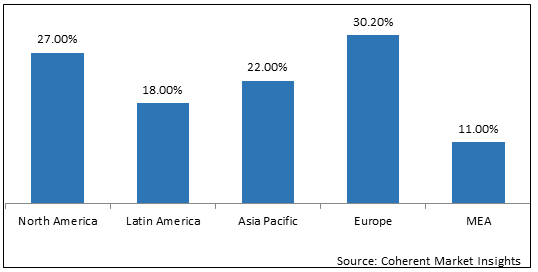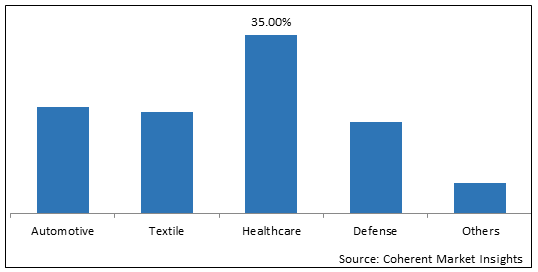Spider silk is a protein fiber that is spun from spiders. The silk is used to create webs or other structures such as nets to catch prey, cocoons to protect the offspring, or to wrap up its prey. The silk is also used for suspension or to float through the air and various others. Extracting the silk from spiders has proven to be a difficult task due to which a synthetic form of spider silk has been created that could be commercialized. It is one of the strongest biomaterials manufactured and is more flexible and stronger than KEVLAR. Owing to its good mechanical properties, spider silk is used as a new biomaterial for ligament and tendon replacement or repair and drug delivery. Furthermore, synthetic spider silk is used in athletic gears, airbags, tire cords among others.
Global synthetic spider silk market was valued at US$ 1059.00 Mn in 2021 in terms of revenue, exhibiting a CAGR of 7.01 % during the forecast period (2022 to 2030).
Drivers
An alternative to spider silk has been created that replicated the spider silk’s strength, energy-absorbing capacity, and elasticity. Moreover, synthetic spider silk contains more than 98% water. Laboratory-based spider silk is made from hydrogel, which consists of 98% water and 2% of cellulose and silica. Silica and cellulose are held together by cucurbiturils. Although, synthetic spider silks are not as strong compared to their natural counterparts, however, they are fairly stronger than other synthetic fibers such as nylon. Furthermore, these spider silks can be made at room temperature without the use of chemical solvents, and these are biodegradable and affordable.
Lockdown imposed due to the outbreak of the COVID-19 pandemic resulted in a temporary ban on import & export and manufacturing & processing activities across various industries, which decreased the demand for synthetic spider silk. This resulted in a decline in market growth in the second, third, and fourth quarters of 2020. However, the synthetic spider silk market is expected to recover by the first quarter of 2021, as the COVID-19 vaccination drive has begun in various economies, which is expected to improve the global economy.
Figure 1. Global Synthetic Spider Silk Market Value Share (%), By Region, 2021

To learn more about this report, Download Free Sample
Market Restraints
The high cost of manufacturing spider silk has hampered the revenue growth of the global synthetic spider silk market. In addition, the cannibalistic and territorial nature of spiders makes it extremely difficult to farm spiders for the commercial production of fabric. Similarly, the limited amount of silk produced by spiders is another restraining factor for the commercial production of spider silk. These factors are expected to hamper market revenue growth during the forecast period.
Synthetic Spider Silk Market Report Coverage
| Report Coverage | Details | ||
|---|---|---|---|
| Base Year: | 2021 | Market Size in 2021: | US$ 1059.00 Mn |
| Historical Data for: | 2017-2020 | Forecast Period: | 2022 |
| Forecast Period 2022 to 2030 CAGR: | 7.01 % | Forecast Period: | 2022-2030 |
| Geographies covered: |
|
||
| Segments covered: |
|
||
| Companies covered: |
Kraig Biocraft Laboratories, Spiber Inc., AMSilk, and Bolt Threads |
||
| Growth Drivers: |
|
||
| Restraints & Challenges: |
|
||
Uncover macros and micros vetted on 75+ parameters: Get instant access to report
Market Trends
Among application, demand for synthetic spider silk in the defense sector is expected to increase by the end of the forecast period. Bulletproof vests are manufactured with Kevlar, a synthetic fiber woven into fabric and layered, thus making it stronger than steel. However, synthetic spider silk, owing to its high tensile strength and elasticity, is considered to be tougher than Kevlar, due to which manufacturers operating in the bulletproof vest industry are looking to incorporate synthetic spiders in their products.
Figure 2. Global Synthetic Spider Silk Market Value Share (%), By Product Type, 2021

To learn more about this report, Download Free Sample
Recent Developments
Competitive Section
Major players operating in the global synthetic spider silk market include Kraig Biocraft Laboratories, Spiber Inc., AMSilk, and Bolt Threads.
Share
Share
About Author
Vidyesh Swar is a seasoned Consultant with a diverse background in market research and business consulting. With over 6 years of experience, Vidyesh has established a strong reputation for his proficiency in market estimations, supplier landscape analysis, and market share assessments for tailored research solution. Using his deep industry knowledge and analytical skills, he provides valuable insights and strategic recommendations, enabling clients to make informed decisions and navigate complex business landscapes.
Missing comfort of reading report in your local language? Find your preferred language :
Transform your Strategy with Exclusive Trending Reports :
Frequently Asked Questions
Select a License Type
Joining thousands of companies around the world committed to making the Excellent Business Solutions.
View All Our Clients